In India, Sustainable Dairy Farming is a year-round business. It is considered necessary to have Sustainable Dairy Farming despite efficient dairy farm management. Buffalo and cow farming are the backbone of India’s dairy industry. Sustainable Dairy Farming has been passed down from generation to generation in India for centuries. During the late 20th century, this tradition declined. However, advances in science and technology have led to huge progress.
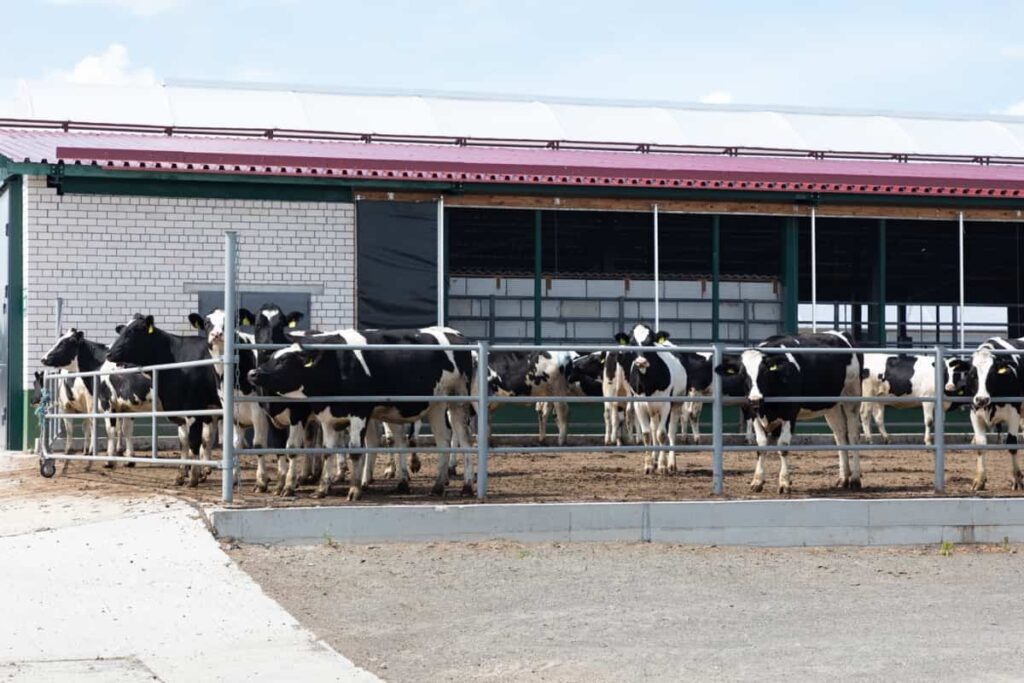
A major contribution of Amul to the ‘White Revolution’ was its contribution to the transformation of the dairy industry in India from agrarian to industrial. Almost 700 million tonnes of milk were produced by 290 million dairy cows worldwide in 2018. With over 50 million dairy cows (17.6% of the global dairy cow population), India has the most dairy cows in the world. Apart from raw milk, milk products such as powdered milk, ghee, and cheese have a huge market. Let’s check out how to start sustainable dairy farming below
In Sustainable Dairy Farming, even the waste is valuable and in demand. Organic compost or vermicompost is made from cow dung or gobar. In organic farming, cow urine is a valuable resource for making ‘panchagavya’ or natural insecticide if you use ‘desi cows’ or Indian breeds. In India, sustainable dairy farming is a new concept emphasizing proper and efficient resource usage without over-exploitation. A farming system’s economic, environmental, and social sustainability is determined by its good management.
How to Start Sustainable Dairy Farming
Choosing Healthy Cattle for Sustainable Dairy Farm
For cattle farming to be successful, this is the first requirement. The animals should be healthy, well-built, and of a healthy weight. Observe the eyes, nose, udders, mobility, coat, and other features before purchasing cattle.
In case you missed it: How to Start Sustainable Sheep Farming: Benefits and How to Reduce Your Carbon Footprint with Sheep

- Eyes: A clear, bright, and discharge-free eye is required. If they appear bloodshot or crusty, they are infected.
- Nose: The muzzle should be moist and licked constantly.
- Breathing: There should be no laborious or irregular breathing in the cows. There is a possibility of infection if there is wheezing during breathing, whether there is discharge or not.
- Coat: It must be clean and glossy with no signs of ticks or lice. A matted coat would indicate the presence of ticks.
- Udder: A healthy uterus must have prominent milk veins sitting forward. They mustn’t appear sagging or meaty. Additionally, the udders should not move sideways when walking.
- Attitude: Generally, animals look self-satisfied and calm, with alert and curious eyes. As a herd, they move about together and are grouped. Symptoms of unhealthiness include animals who stand apart from their surroundings or seem uninterested in their surroundings.
- Age: The animal’s age can be determined by its dentition, although this does not necessarily indicate good health. Establishing and managing a dairy farm efficiently requires determining the cattle’s age.
- Mobility: Animals need to get up easily from a sitting position without any limps or difficulties. Deformities and abnormalities are exhibited by hunching over and limping.
- History: In addition to looking at the animal’s history, such as previous calvings, milk yield, hypocalcemia, etc., it is important to consider its current condition.
Shelters in Dairy Farm
Animal shelters play an important role in optimizing yields. Productivity declines due to stress and weather changes. The housing facilities must be clean and spacious, allowing for natural air circulation and sunlight exposure. Cattle sheds must have a floor area of 10 feet X 5.5 feet per animal with a slope of 1.5% toward the drain. A rough concrete floor is required. Ten feet is the minimum height for sheds. Bricks and RCC may be used in their construction, or they can be thatched.
In case you missed it: Sustainable Poultry Farming: Benefits and How to Reduce Your Carbon Footprint with Chickens
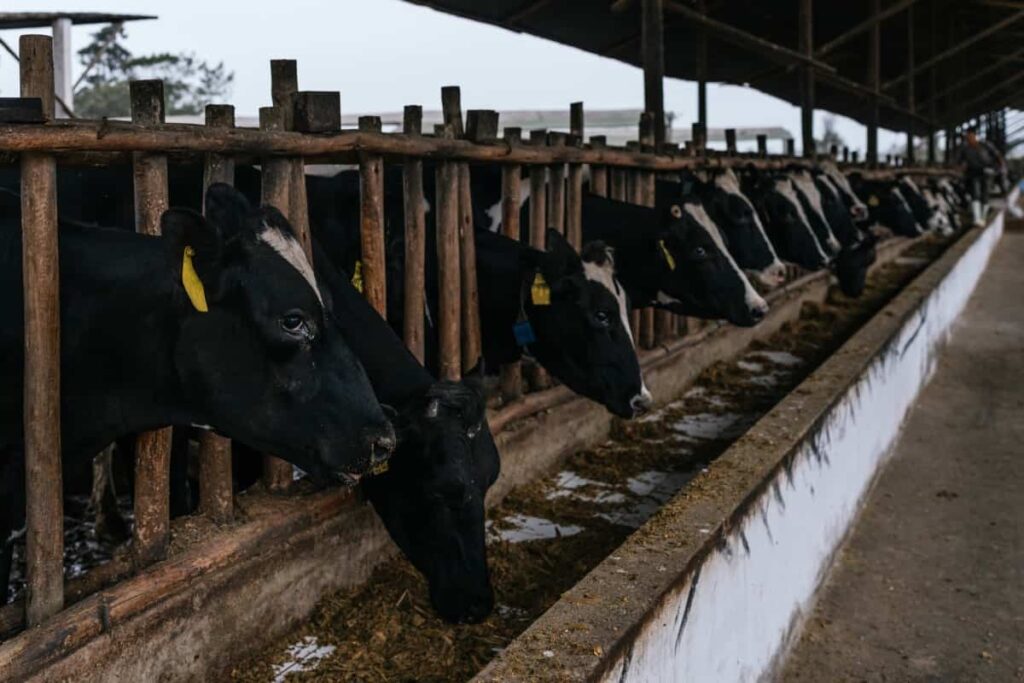
Three sides of the shed must be open, with only the western side walled. During winter, however, the open sides must be covered with gunny cloth to keep the animals warm. Water should also be sprinkled on the animals every half hour during summer. As a result, heat stress is greatly reduced. The eastern side of the shed should be open to the outdoors for free roaming.
In the roaming area, neem and mango trees provide the most shade. In the shed, the mangers are located on the western side. Their height is one foot above the floor, two feet wide, and one and a half feet deep. It is necessary to keep drinking water near the manger. Construction of the mangers generally occurs simultaneously with the construction of the shed. A separate box may be provided as a manger in some places.
Animal Feeding in Sustainable Dairy Farming
Food is one of the most basic needs of living beings since, without it, they would perish. The cost of feeding cattle accounts for 70% of the cost of milk production. Various cattle feeds are available for cattle, including fodder, grains, bran, green fodder, straw, oil cakes, and others. A normal adult animal needs 15-20 kilograms of green fodder and 6 kilograms of dry fodder per day. During the flowering stage, green fodder is harvested, and surplus fodder is preserved for haymaking.
Summertime is when preserved fodder is used when fresh green fodder is unavailable. For optimal milk production, the various nutrient requirements must be balanced. Animals fed exclusively dry fodder must be supplemented with Urea Molasses Mineral Block. Bypass protein or compound cattle feed is fed to them for efficient milk production and better body maintenance.
In case you missed it: Unlocking the Potential Of Sustainable Aquaculture: How to Start and What You Need to Know

If the feed needs to be changed, the change must be gradual. It is recommended that fodder be chaffed and fed three to four times daily in equal intervals to increase digestibility and reduce wastage. In this rationing system, wastage is reduced, and digestibility is increased. The proper nutrition and care must be given to female calves to ensure they grow quickly and healthily.
As a result of rapid growth, they reach puberty early. These animals calve at 2 to 2.5 years of age if insemination is given at the right time. Due to the rapid development of the fetus during the last three months of pregnancy, maximum care should be taken during these months. Pregnant animals require the following food daily:
| Food | Weight |
| Green Fodder | 15-20 Kg |
| Dry Fodder | 4-5 Kg |
| Compound Cattle Feed | 3 Kg |
| Oil cake | 1 Kg |
| Mineral Mixture | 50 Grams |
| Salt | 30 Grams |
Water Requirements in Sustainable Dairy Farming
Digestion, nutrient distribution, excretion, body temperature maintenance, and milk production require water. Milk contains 85% water, so for every liter of milk produced, 2.5 liters of water is needed. As a result, a healthy adult animal requires 75 to 80 liters of water daily. During the summer, this can increase to 100 liters. The water they drink must be clean. Crossbred buffaloes and cows are bathed twice daily to maintain their body temperature during summer.
Healthcare for Pregnant Animals and Post-Calving Care
Things to Remember
- Ensure that there is enough space for people to stand and sit comfortably.
- The ratio must be adequate to ensure timely milk production and prevent milk fever, ketosis, etc., at calving time.
- During pregnancy, special care should be paid to water requirements; clean drinking water should be available around the clock.
- Pregnant animals must not be taken far away for grazing, and uneven paths should be avoided during the last trimester.
- After the seventh gestation month, lactating animals must be dried within 15 days.
- Massage the cow’s body, back, and udders from the 6th or 7th month of pregnancy, especially if it is her first or second pregnancy.
- In the 7th month of pregnancy, heifer cows are tied to the milking animals.
- For about 4-5 days before calving, pregnant animals are kept separately in a clean, dry area with ample sunlight.
- The ground is covered with paddy straw, used as animal bedding.
- The animals are closely monitored in the two days leading up to the calving.
Post Calving Care and Nutrition
During calving, animals experience a great deal of stress. As a result, they would have a low appetite and consume much less food than their body requires. Due to their low appetites, cows and buffaloes are fed wheat bran, boiled rice, wheat mixed with edible oil, jaggery, boiled millet, ginger, black cumin, rice gruel, etc.
Ideally, the food should be light, warm, palpable, and mildly laxative. During the first couple of days after calving, this diet helps in the early expulsion of the placenta. Fresh green fodder and water should be provided to the animals. Water must not be boiled or hot, while the rationed food must be warm. Fresh water should be used. Cows need clean drinking water to milk properly, or they will become ill.
In case you missed it: How to Start Sustainable Pig Farming: Business Plan, Benefits, and Requirements
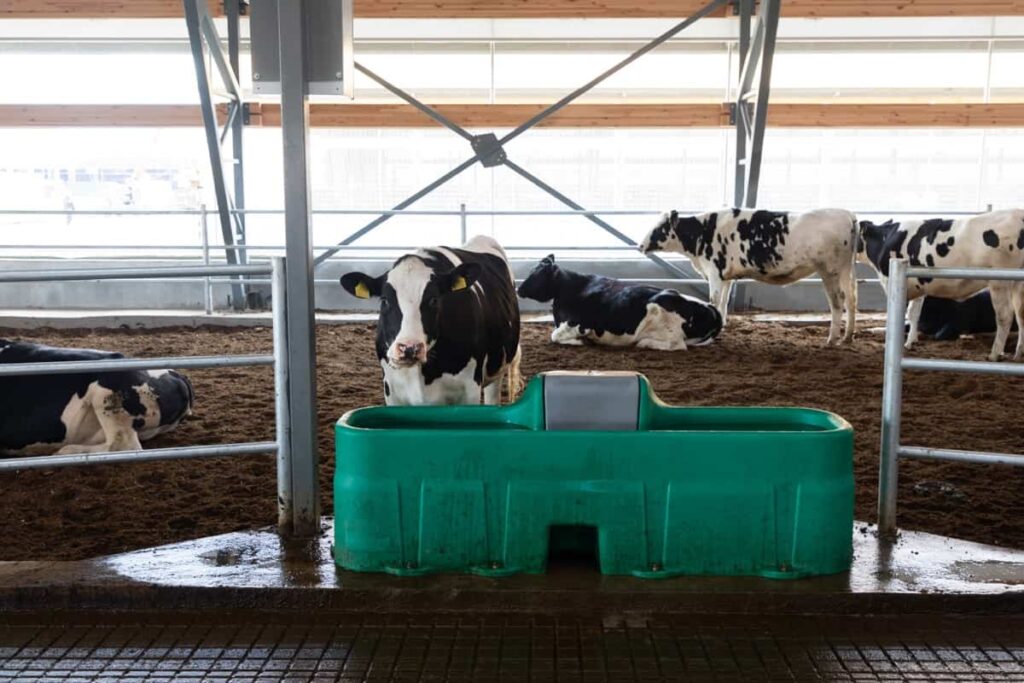
Vaccination in Sustainable Dairy Farming
It is common for certain diseases to be endemic, such as foot and mouth disease, black quarter, hemorrhagic septicemia, rabies, infectious bovine rhinotracheitis, theileriosis, and anthrax. Dairy businesses suffer heavy losses due to these factors. The good news is that vaccinations can control them. Below is a schedule of vaccinations:
| Name of Disease | First Dose | Booster Dose | Subsequent Doses |
| Foot and Mouth Disease | Four months and above | One month after the first dose | Every six months |
| Black quarter | Six months and above | Once every year in case of endemic occurrence | |
| Hemorrhagic Septicemia | Six months and above | Once every year in case of endemic occurrence | |
| Rabies | Immediately after the suspected bite | 4th day | 7, 14, 28, and 90 days after the first dose |
| Infectious Bovine Rhinotracheitis | Three months and above | One month after the first dose | Every six months |
| Theileriosis | Three months and above | Once a lifetime dose is needed only for exotic and crossbreeds | |
| Anthrax | Four months and above | Annually in the case of endemic areas | |
| Brucellosis | 4-8 months of age in female calves | Once a lifetime |
In case you missed it: Sustainable Goat Farming: Business Plan, Benefits, and Requirements
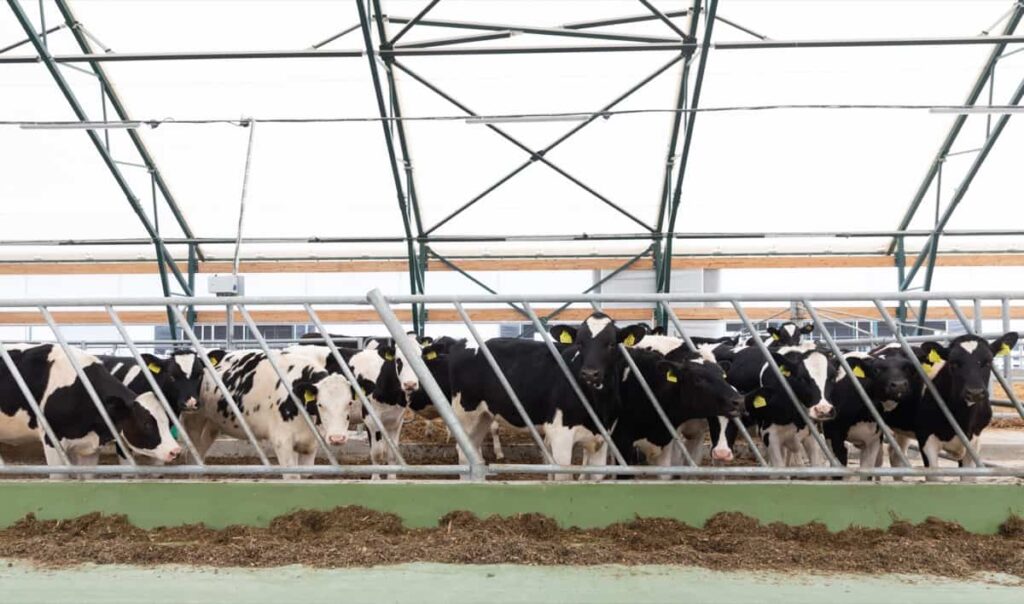
Challenges in Sustainable Dairy Farming
There are many challenges faced by sustainable dairy farming in terms of sustainability, such as agroclimatic conditions, the socio-economic status of people, the type and breed of cattle raised, etc. Unavailability of fodder and unavailability of land for fodder cultivation are common challenges for sustainable dairy farming, excessive chemical usage in agriculture and animal husbandry practices, a lack of knowledge about animal diseases, unhygienic milk production practices, greenhouse gas emissions, and marketing problems.
Strategies for Sustainable Dairy Farming in India
Diet formulations that are more efficient will contribute to sustainable dairy farming’s sustainability. A surplus of protein can result in ammonia and nitrous oxide being released into the atmosphere, both harmful greenhouse gases. It has a bad effect on the environment and results in a financial loss for the dairy farm. Among the best strategies for sustainable dairy farming are feeding practices such as
- Using available feed resources efficiently by reducing feed losses
- Expanding the feed resource base
- Enhancing the availability of fodder
- Intestinal tracts become more nutrient-available
- A greater emphasis will be placed on the production of ruminants
- A nutrient management plan is framed by improving soil health
- Animal husbandry practices that include deworming, vaccination, disease prevention, and control
- Mitigation of greenhouse gas emissions through clean and hygienic milk production, etc.
Advantages of Sustainable Diary Farming Over Other Livestock Farming
- Nowadays, the milk production industry is the most desirable worldwide. Milk and milk products have huge demand in the market. This is the main benefit of starting a commercial dairy cow farming business.
- Demand for milk and its products will never reduce because vegetarians and non-vegetarians will have milk.
- You don’t need to worry about marketing the products because it is a traditional business, so that you can sell them easily.
- It is an eco-friendly business.
- You can increase dairy production through mechanization instead of using labor.
- Proper planning, management, and taking good care of your animals will provide maximum profit. So, you will get a great source of income.
In case you missed it: Humic Acid Fertilizer Uses: Role, Application Methods, Dosage, and Benefits for Sustainable Agriculture
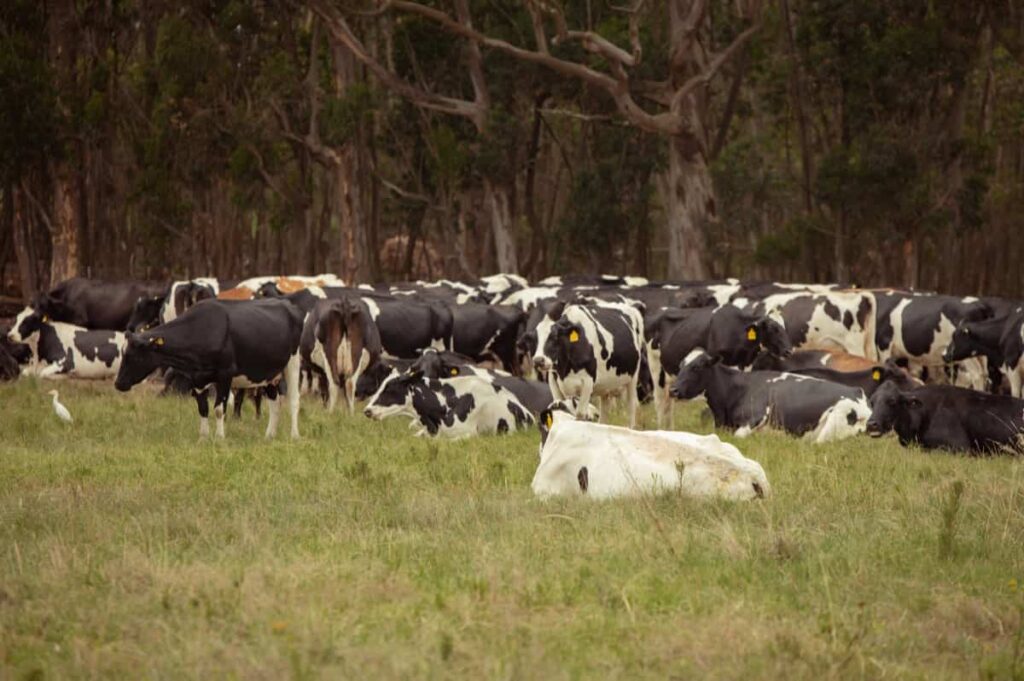
Conclusion
Dairy cattle benefit the world by upcycling inedible human feedstuffs into milk and dairy products. As beneficial as this process has become, it has potential drawbacks. The fermentation of enteric and waste materials by dairy cattle and the emission of nitrogen by their feces and urine contributes to greenhouse gas emissions. In addition to contributing to a more sustainable dairy production system, sustainable farming practices will reduce the environmental impact.
- How to Raise Pigs in Your Own Backyard: A Comprehensive Guide
- Budget Friendly Sheep Shed Ideas: Cheap and Low-Cost Tips
- How Much Do Cattle Farmers Make: Revenue Streams in Cattle Farming
- Management Pests and Diseases in Your Cotton Field
- Sheep Farming Business Plan for Beginners
- Aquaponic Farming at Home: A Step-By-Step Guide
- Profitable Village Farming Business Ideas in 2024
- High-Yield Aquaculture: Fast-Growing Fish for Farming
- Effective Fish Pond Construction Techniques for Beginners
- Irrigation and Water Management in Pineapple Farming
- Blossom to Harvest: Mastering Flowering and Pollination in Papaya Farming
- Pig Fattening Essentials: From Selection to Sale for Beginners
- Raising Wagyu Cattle: A Complete Guide for Premium Beef Production
- Soil Types and Their Water Holding Capacity
- Optimizing Irrigation Schedules for Coconut Groves for Enhanced Yield
- Espresso Your Garden: Coffee Grounds for Healthier Acid-Loving Plants
- The Best Soil Mix for Snake Plants: How to Mix Your Own Snake Plant Soil
- Green Thumb Success: Expert Tips for Cultivating Greenhouse Beans All Year Round
- Bloom All Year Round: The Ultimate Guide to Indoor Hyacinth Care
- Eco-Friendly Gardening: How to Make Liquid Fertilizer from Kitchen Waste
- Ultimate Guide to Grow Anise in Pots: Explore Seed Propagation to Harvesting
- Guide to Raising Chester White Pigs: Discover Breed Facts to Growth Management
- Mastering the Elegance: The Ultimate Guide to Weeping Cherry Tree Care, Planting, and Maintenance
- Ultimate Guide to Planting Garlic in Grow Bags: Growing Strategies for Beginners
- How to Fix Spider Plant Leaf-Related Problems: Natural and Organic Remedies
- 10 Reasons Why Your Tulsi Plant is Shedding Leaves: Home Remedies and Solutions
- Optimizing Growth and Yield: The Advantages of Palm Bunch Ash Fertilizer
- Utilizing Neem Oil Extract as a Natural Pesticide for Hydrangea
- From Soil to Harvest: Various Ways in Which Farmers Can Use AI Tools
- Steps to Encourage and Induce Citrus Flowers: A Comprehensive Guide
- How to Fix Snake Plant Leaf-Related Issues: Natural and Organic Remedies
- Transform Your Garden into a Fragrant Oasis with Raat Ki Rani (Night Blooming Jasmine)
- Discover the Ideal Chicken Breeds for Philippine Farms
- How to Create a Poultry Egg Farm Business Plan for Profits
- Grow Lemon Cucumbers Like a Pro: Insider Techniques for Bountiful Yields
- Ultimate Guide to Caring for Your Pink Princess Philodendron: Tips for Thriving Variegation
